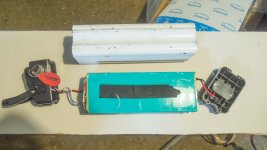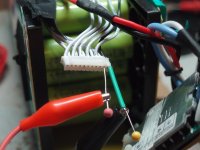How difficult is it to check if the cells are balanced, whether it has a BMS, in my 3 year old 48V 28 AH lithium battery?
You own an Arrow with a tall silverfish battery. In my opinion, the silverfish case is a pretty durable, well designed case that has been around for over 10 years. Sticks around because even though it costs more than a plastic box, it works,
I've got one silverfish. Here, I've removed the ends and pushed the battery package out. It was held with adhesives, so I had to insert long blades to cut the glue.

You could probably do this without pushing the cells out, but it does make it easier to open the shrinkwrap to access the BMS. This battery happens to be well made under the green shrink wrap, with a fiberboard covers under it, protecting a plastic frame. Some cheap designs just glue the cells together, without a frame, which is dangerous if they get loose.

Then you can access the balance connector to measure the voltages. I use pins to get inside the smale holes, where my voltmeter probes cannot go.

As Neptronix said, it's a hazardous job if you happen to short circuit a wire and send 50 amps thru it. I wouldn't recommend it, if you're just curious.
As long as the battery gives you a good range, leave it alone. If it starts shutting off after ten miles orless, then it's unbalanced. You still gotta leave it alone. Unbalanced packs are really hard to fix and keep them fixed. If you replace the bad cells, there are others bound to do the same thing.
As for the above battery, I replaced five bad cells and felt pretty smart. Then another five cells went bad over the winter. I bought a new battery and gave the bike to my son.





